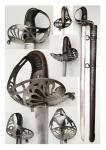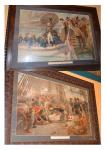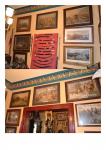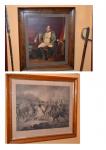-
Posts
48 -
Joined
-
Last visited
-
Days Won
1
Content Type
Profiles
Forums
Blogs
Gallery
Events
Store
Everything posted by Cathey
-
Brass hilted Highland Officer’s Basket Hilt Pattern 1798 Overall Length: 94.8 cm (37.3 inches) Blade length: 80.6 cm (31.7 inches) Blade widest point: 2.985 cm (1.2 inches) Hilt widest point: 13.4 cm (5.3 inches) Inside grip length: 10.3 cm (4.1 inches) Marks, etc: Marked with a crown GR DRURY, stamped near the hilt are the letters EC with 6 small stars. The stars appear to have been applied to strike out other letters. These letters look like R.I.I.J.I.R? Description 1798 Pattern Highland infantry officer's backsword; the type carried by Scottish infantry regiments during the Peninsula War and Battle of Waterloo against Napoleon's forces. The single fullered blade is marked with a crown GR DRURY, stamped near the hilt are the letters EC with 6 small stars. The hilt is brass hilt is constructed of solid plain panels and has remnants of past gilding. The grip is fish skin with brass wire. These are usually seen with broad sword blades, however this is a backsword. The 1798 Pattern was the first attempt by the British to standardize sword patterns for the Scottish regiments and was very loose in some respects, with blades coming from Solingen (Prussia / Germany), England and Scotland, clearly with officers mounting the blades from their existing pre-pattern swords. The brass hilt is fundamentally weaker than steel hilts, hence the pattern is rare as the hilts suffered terribly over time. Cheers Cathey & Rex
-
HEAVY CAVALRY OFFICER’S UNDRESS SWORD Circa 1796-1821 English hilt, German Blade Overall Length: 104.3 cm in scabbard (41.1 inches) 101 Sword only (39.8 inches) Blade length: 87.3 cm (34.4 inches) Blade widest point: 3.7 cm (1.5 inches) Hilt widest point: 12.4 cm (4.9 inches) Inside grip length: 11.5 cm, (4.5 inches) 17 turns of wire binding around the grip Marks, etc: Steel scabbard bares the names Woolley & Deakin. Blade signed near hilt J. J. Runkel Solingen Description: Pattern 1796 Ladder Hilt Heavy Cavalry undress officers sword, has a broad long single-edged blade with a hatchet point and the guard is an open work steel bowl decorated with scrolls in the form of the petals of the honeysuckle flower. Very good Condition, scabbard bares the name Woolley & Deakin. The blade is German marked faintly J. J. Runkel Solingen. This sword is described by Ffoulkes & Hopkinson, Sword, Lance and Bayonet and Wilkinson-Latham, British Cut and thrust weapons as having been developed in 1834. Robson, Swords of the British Army does not agree and maintains that this hilt was introduced in 1796 and remained the regulation for heavy cavalry officers until 1821. General Remarks Blade made by J. J. Runkel – Solingen, Prussia 1780-1800. Many of his blades were hilted to become Highland broadswords of Scotland. Waterloo Sword Collector Haydn Vesty: 1796 Pattern Ladder Hilt Officers Undress, probably late make but no later than 1810. References: Bonhams, 1/4/04 Lot 322 pp100 BULL, S. European Swords Shire 298 Album. Pp22. DUFTY, A. European Swords & Daggers in the Tower of London. pp 31, plate 81,d ROBSON, B. Swords of the British Army pp 85, plate 65,90,128, plate 110. SOUTHWICK, L The Price Guide to Antique Edged Weapons pp 125. plates 330,332 WILKINSON-LATHAM, J. British cut and thrust weapons. Pp 15, plates 9. WILKINSON, F. Edged Weapons. Pp 148.
-
Hi Jonathan, Your right is should be 19th or late 18th, without a maker it is impossible to pin point. What are your thoughts on the possible Scottish connection? it was only recently I noticed the Scottish thistles on the blade. Cheers Cathey
-
BLACK WATCH BASKET-HILT Date: Circa 1750-70 (18th Century) Scottish Black Watch 42nd Highland Regiment Overall Length: 96.8 cm (38.1 inches) Blade length: 82.8 cm (32.6 inches) Blade widest point: 3.5 cm (1.4 inches) fuller runs 63.9 cm (25.2 inches) Hilt widest point: 16 cm (6.3 inches) Inside grip length: 12 cm (4.7 inches) Marks, etc: Nil Description: English Black Watch basket-hilted backsword for highland regiments (42nd Royal Highland Regiment), c1750-70. Straight single edged fullered blade. Although unmarked the hilt pattern suggests the Maker to be Jeffrey’s of London. Regulation Jefferys hilt, panels pierced with triangular darted and circular openings, line engravings included in panel decoration. The three branches of the guard are riveted to a ring which fits around the truncated conical pommel with spherical button, leather grip wire missing. General Remarks: Slight differences in Guard construction indicates this sword was supplied by Nathaniel Jeffery’s London. No maker, retailer or Military marks found. It is not until 1759 that a supplier of swords can be identified in documentation: Nathaniel Jefferys of London. In October of that year he delivered 3500 “Broad swords with iron baskets and paste-board scabbards” at five shillings each to the Board of Ordinance. The London trade directories record a Nathaniel Jefferys, goldsmith, located at 32 Strand, corner of Villiers Street, from c 1768-1779. After this date, Jefferys was succeeded by the firm of Dru Drury & Son but it appears that Drury and Jefferys had been in some kind of partnership since around 1770 as the directories record Dru Drury at the same address from that year. References: BEZDEK, Richard H. SWORDS AND SWORD MAKERS OF ENGLAND AND SCOTLAND Pp341 DARLING, Anthony D. SWORDS FOR THE HIGHLAND REGIMENTS 1757 - 1784 published by Andrew Moebray Inc pp13. Wallis & Wallis Connoisseur Auction Autumn 2001 9-10/10/2001 Lot 100
-
Hi Mervyn, Stuart said you wanted me to post some more swords, here is the first one. Looking forward to chatting on Skype Saturday. Date: Pattern 1796 (18th Century) This sword probably produced in early 19th but who really knows. Overall Length: 87 cm (34.3 inches) in scabbard, 83.7 cm (33 inches )sword only Blade length: 72.6 cm (28.6 inches) Blade widest point: 3.286 cm (1.3 inches) Hilt widest point: 14 cm (5.5 inches) Inside grip length: 8.9 cm (3.5 inches) Marks, etc: Initials TRBC, Blue and gilt decoration crowned post 1801 Royal Arms, the crowned Royal GR cypher and foliage including Scottish Thistles. Description: Georgian 1796 Pattern Light Cavalry Officer's Blue & Gilt Sword Curved blade double-edged towards the tip, blue and gilt decoration covering three-quarters of its length, crowned post 1801 Royal Arms, the crowned Royal GR cypher and foliage including Scottish Thistles. Steel stirrup hilt including a pair of langets with faceted borders, knuckle guard and back-strap each decorated with a pair of vertical notched bands, original fishskin-covered grip bound with twisted silver wire, and the hilt retaining traces of an early silvered finish, in its leather scabbard with shaped steel mounts engraved with linear ornament, and engraved with the owner's initial 'TRBC'. General Remarks Post 1801 arms, May not be cavalry, it has been suggested that it might be Rifles. Initials TRBC, could be JRBC, difficult to be sure. The presence of Scottish thistles in the decoration may indicate the sword was made for a Scottish officer possibly Yeomanry or Militia (Volunteers). Cheers Cathey and Rex
-

RARE HISTORICAL MILITARIA PRINTS
Cathey replied to Mervyn Mitton's topic in Great Britain: Research, Documentation & History
Hi Mervyn Here are the two Nelson prints you asked for. The first one has the title “Good-bye, my Lads!” Nelson leaving Portmouth to Sail for Trafalgar on the Victory.” The second print is titled “The Hero of Trafalgar” Nelson on Board the Victory October 21st 1805”. Cheers Cathey and Rex -

RARE HISTORICAL MILITARIA PRINTS
Cathey replied to Mervyn Mitton's topic in Great Britain: Research, Documentation & History
Hi Mervyn Here is the Thin Red Line. This one is an artist’s proof with a pencil drawing of one of the character’s in the corner and a brass plate reading “The Thin Red Lin 93rd Highlanders Repulsing Russian Cavalry Balaklava, 25th October 1854”. This print is by Robert Gibb 1881 and signed by the artist in pencil. I will post the Nelson Prints next. Cheers Cathey and Rex -

Uniform ID
Cathey replied to Stuart Bates's topic in Great Britain: Militaria: Badges, Uniforms & Equipment
Hi Stuart A nice piece of detective work Stuart or should I say Sherlock Cheers Rex -

RARE HISTORICAL MILITARIA PRINTS
Cathey replied to Mervyn Mitton's topic in Great Britain: Research, Documentation & History
Hi Guys as you can see we are keen on military prints, if you want close ups of any of these let us know and we will try. Cheers Rex -

RARE HISTORICAL MILITARIA PRINTS
Cathey replied to Mervyn Mitton's topic in Great Britain: Research, Documentation & History
Hi guys Large Oil Painting of a young Napoleon by myself, based on a combination of various old prints and including Napoleons coat of arms. I had intended to do a matching Wellington, but I am extremely time poor. Cheers Cathey -

RARE HISTORICAL MILITARIA PRINTS
Cathey replied to Mervyn Mitton's topic in Great Britain: Research, Documentation & History
Hi sorry about the delay in posting prints, but Rex does not know how to post and has to wait for me to help him. The first print is Napoleon looking very dejected, no artists names present, the second is call Napoleon and his Generals. Cheers Cathey and Rex -
Medals-James Stott (Gordon Highlanders and Cameron Highlanders) The items in this group came from the estate of James Scott and consist of a large silk picture dedicated to the Gordon Highlanders, Gordon Highlander silver shooting medal, Gordon Highlander Queen’s South Africa Medal 1899 with four bars. Gordon Highlander King’s South Africa Medal 1902. Cameron Highlander 1914-15 Star. Cameron Highlander 1914-20 British War Medal. Cameron Highlander Victory Medal 1914-19. Corp of Commissionaires Medal. Gordon Highlanders - Rank Private to Sergeant in Boer War Queen’s South Africa Medal, Service No: 3434 Pte J Stott GORDON HIGHS. Date: 1899. Campaign: Anglo-Boer War 1899-1902. 4 Clasps Belfast, Laing’s Nek, defence of ladysmith & Elandslaagte. King’s South Africa Medal, Service No: 3434 Serjt’s J Stott GORDON HIGHS Date: 1902. Campaign: South Africa 1901- Shooting Medal Silver SGTS SHIELD SHOOTING COMPETITION 2ND SERGT J STOTT 1909 Cameron Highlanders - Rank Sergeant to Acting Warrant Officer Class 2 WW1 1914-15 Star, Service No: 1511 C.O.M SJT J Stott Camerons Date: 1918. Campaign: First World War 1914-15. 1914-20 British War Medal Date 1919, Campaign: First World War, 1914-20. Date: 1919. Campaign: First World War, 1914-20. Victory Medal 1914-19 Date: 1919. Campaign: First World War 1914-19. Corp of Commissionaires Medal, ribbon red, white & Blue, Metal Silver. Size 40mm. Description: A 16 point star bearing a central medallion with the Union Jack in the centre surrounded by the Latin mottoes: VIRTUTE ET INDUSTRIA (Top) and LABOR VINCIT OMNIA (Foot – “by valour and industry” and “work conquers all” respectively. Comments: Awarded by the Corps of Commissionaires for long and exemplary service.
-
London Scottish, can anyone help? The London Scottish Museum in the UK has no record of an officer with the initials PHHB, however the engraved initials do not appear to have been added latter as is often the case with Scottish swords. I have checked through my Harts and Arms list with no joy. The sword turned up in America so I am wondering if there was a branch of the London Scottish there, I am at a loss to identify this chap and any help will be gratefully received. Pattern 1828 Officers Basket Hilted Sword to London Scottish Date: Circa 1987-1902(19th Century) Overall Length: 102 cm (40.2 inches) Blade length: 82.6 cm (32.5 inches) Blade widest point: 3 cm (1.2 inches) Marks, etc.: Imperial Crown, Owner's Initials. PHHB Description This is a Scottish regimental basket hilt for the London Scottish Volunteers, and has the original owner's initials on the blade. The sword has a crack in one bar, other wise it is complete, and tight, in its original scabbard. The guard and scabbard are nickled, with no losses at all except on the ball at the tip of the scabbard, which is dented from carrying. There are minor flecks on the scabbard. The grip is fine grey sharkskin with triple wire wrap. The silk tassel is present, as is the basket liner. The ribbon that edges the liner is tattered. The double edged blade has the Imperial crown over Queen Victoria's cipher, which dates this between 1897 and 1902. The other side of the blade has the Imperial crown over London Scottish Volunteers. Below that are the owner's initials: PHHB. The blade is also etched with panoplies of thistles. The proof mark is a crown over "PROVED." Cheers Cathey and Rex
-
Full Dress Badger Sporran Officers Argyll and Sutherland Highlanders (Princess Louise's) Date: Victorian Circa 1890 Nationality: Scottish Dimensions: 21 cm wide x 34 cm long Description: Officer's Full Dress badger sporran of the Argyll and Sutherland Highlanders (Princess Louise's), plain gilt brass cantle, badger head with glass eyes, six white hair tassels in gilt thistle sockets on gilt cords, red leather pouch. Sporran is in excellent condition overall, although it dose tend to malt when moved. Cheers Cathey and Rex
-
TARGE Date: Circa 1700 (18th Century) Nationality: Scottish Dimensions: 45.5 cm (18.1 inches) diameter,1.9 kg (4.2 lbs) Marks, etc.: Remnants of an old label stuck to the back which appears to read McKenzie Brothers Union St Inverness. Description: Scottish Targe appears original, with correct wood board construction covered in smooth leather. The front is decorated with Celtic designs of concentric circles in studs, roundels, Iron bosses and brass triangular plates. This example was reputedly hanging in a Scottish museum over one hundred years in Inverness before resurfacing in the hands of elderly gentlemen entering an Arms Fair in London. The Targe still has remnants of an old label stuck to the back which appears to read McKenzie Brothers Union St Inverness. General Remarks The story behind this Targe is as follows: a friend of ours Lynton was on his way into an Arms Fair in London when he spotted an elderly gentleman entering the fair with this Targe under his arm and what turned out to be a highly decorative Italian Maine Gauche. The gent advised that the Targe had been hanging in a Scottish Museum in Inverness for over 100 years and was then latter used as a display piece in the shop of the Highland Dress and Ornament Makers Mackenzie Brothers, the remnants of whose label can still be seen on the back of the Targe. Lynton purchased both items on the steps of the fair and later they passed on to us. Note: MACKENZIE BROTHERS Only a small amount of detail has been noted regarding the firm of MacKenzie Brothers of Inverness. It is certain that they were in business from 1881 until at least 1893, they were first located at 17, Lombard Street, Inverness, an address that was also known as 'The Lombard Street Manufacturing Jewellery and Watchmaking Establishment', in July 1890 they advertised: MacKenzie Brothers, Jewellers, Watchmakers, and Highland Ornament Manufacturers, of 17, Lombard Street, have moved to 22, Union Street. MacKenzie Brothers occupation of this address appears to have been short lived, as by 1893, as can be seen from the advertisement, they had relocated to 26, Union Street, Inverness. Cheers Cathey & Rex
-
Basket Hilt Dragoon Sword Date: Circa 1745-1780 (18th Century) Nationality: British Dragoon Basket (Scottish Regiment) -Scottish Patriotic Blade Overall Length: 107.2cm (42.2 inches) Blade length: 91.4 cm (36 inches) Blade widest point: 3.687 cm (1.5 inches) Marks, etc: engraved "this was the sword of the immortal saviour" below this is the Scottish Lion flanked on either side with foliage decoration then below that the words " Wallace Regent of Scotland A.D. 1298." Description: British Dragoon Basket Hilt with a Scottish back sword blade with two fullers, double edged for last 11 " (28.1 cm). Along the top of the area of decoration on the blade are the words "this was the sword of the immortal saviour" below this is the Scottish Lion flanked on either side with foliage decoration then below that the words " Wallace Regent of Scotland A.D. 1298." The other side of the blade appears to have had its decoration removed when the sword was restored having had its blade bent over at the hilt. General Remarks I believe that this sword originally came to Australia from Arbour Antiques London where it was purchased by a friend of mine several years ago. When Arbour received the sword, the blade had been completely bent over as if someone had sought to destroy it or at least render it useless. My understanding is that Arbour had the blade reheated and straightened and the sword restored to its current good condition. Reheating the blade has removed colour from one section. The sword has a typically English Pommel but there is an area of engraved decoration that does not seem to fit with the sword serving in an English Regiment. Along the top of the area of decoration are the words "this was the sword of the immortal saviour" below this is the Scottish Lion flanked on either side with foliage decoration then below that the words "Wallace Regent of Scotland A.D. 1298." Clearly the sword is not that old so the owner has added this decoration as a patriotic Scott, given the English executed Wallace I have difficulty believing the sword belonged to an Englishman. Further, it is hard to accept that an English soldier would dare carry a blade in the memory of William Wallace, or that a Scot serving in an English regiment would take such a risk. Advice in regards to the age of the sword range from 1745 through to 1780. One collector has suggested that apart from being very odd, the pommel and the basket are English dragoon 1760 thru to 1780. The blade he feels is older, possibly a pickup form the battle of Culloden, 1746. There were many English troops who picked up the swords after the battle and kept them as they were better then what they had. However, if you where English would you carry such a blade? Another collector believes it to be circa 1745 with an Etched Patriotic Blade belonging to an Officer in Scottish Dragoon Guards regiment, which where part of the British Cavalry. Cheers Cathey and Rex
-
Hi Simon, While I am happy to stand corrected I don't believe the heart design has a particular significance. Personally I think it simply evolved from the earlier triangle with dart design, that had two small circles at it base. Merge the circles into the triangle and you have a heart. The heart became very clearly represented in the regimental pattern on 1828, however I have also seen variations to this design in officers swords made by private treaty. Attached are four swords from my collection that illustrate my thoughts on this subject. Cheers Cathey
-
Scottish Colonels/Generals Basket Hilted Broad Sword Date: 1790-1810 Nationality: British Overall Length: 97.2cm (38.3 inches) Sword Only Blade length: 80.8cm (31.8 inches) Blade widest point: 3.401cm (1.3 inches0 Marks, etc.: marked FIRMIN & SON SWORD CUTLERS TO HIS MAJESTY 153 STRAND LONDON Description Basket Hilt-Scottish-c1790 Highland Officer broad sword Scottish Colonels/Generals Officers Basket Hilted BroadSword with Gold guilt hilt, 85% gold gilding remaining. Comprising connecting junction panels pierced with hearts and circles and cut with scalloped edges, fluted domed pommel, withits original crimson and buff leather liner, shark skin wire wrapped grip 32" double fullered blade marked FIRMIN & SON SWORD CUTLERS TO HIS MAJESTY 153 STRAND LONDON; circa. 1790-1810, complete with correct brass mounted leather scabbard missing chape Firmin & Sons operated at 153 Strand London from 1783 upto 1796 Cheers Cathey and Rex
-
Scottish Field Officer's SwordDate 2nd February 1856 Pattern 1857 Over Length 101.5 cm (39.9 Inches) in scabbard 96 (37.8 inches) sword only Blade length 82.3 cm (32.4 inches) Blade widest point 2.938 cm (1.2 inches) Description An undress sword formerly owned by Lt. Colonel McCall of the 79th Cameron Highlanders. Made by Henry Wilkinson Pall Mall London, proportionately smaller guard of the 1821 Heavy Cavalry undress pattern, fish skin covered wire bound grip, the back piece with chequered thumb stop and domed chequered pommel. Slightly curved 32 " inch x 1" inch cut and thrust single edged blade, proof No. 7565 finished 2nd February 1856. The blade is etched with a scroll with W. McCALL and with his crest and motto and crowned VR ciphers within foliate scrolls, with a steel scabbard. General Remarks McCALL. William served in the Cameron Highlanders. He was ensign, 29th of March, 1839; lieutenant, 8th of June 1841; captain 14th of November 1841; major 12th of December 1845 ; brevet-lieutenant-colonel 2nd of November 1855 ; half pay on the 5th of August 1857. He served with the regiment in the Eastern campaign of 1854-55, including the battles of Alma and Balaclava, expedition to Kertch and Yenikale, siege and fall of Sebastopol, and assaults of the 18th of June and the 8th of September. (Medal with three clasps, brevet of lieutenant-colonel, Knight of the Legion of Honour, 5th class of the Medjidie, and Turkish Medal.) His medals are in the Officers Mess at the Regimental Depot. Captain McCall as described in the Memoirs of Colonel E W Cuming in the 79th News in July 1935 “Captain McCall was a kindly creature. His name was William, but he was always called Charles; why, I don’t know. He was a very practical turn of mind. He was a great dandy, always dressed in the extreme of fashion. His Company was always known as the Lancers, for some reason connected with its Captain. He never was exactly sure of anything. His talents lay in riding; he was a neat horseman and was the regimental race rider”. Cheers Cathey and Rex








